Guizhou
CNN
—
In China’s southern Guizhou province, there’s a tiny village in the southeast corner, nestled deep within the mountains, called Dali. A wall of lush green trees and bamboo surround this village of about 1,000 people, who’ve lived in wooden homes with gray-tiled roofs for centuries.
It’s the Lunar New Year, and during the daytime, the doors are rarely closed. People here say they’re all relatives, and the village is like one big family. Almost everyone shares the surname Yang, except for a few families with the last name Li or Wang. Most people I met asked me to call them “Xiao Yang” or “Little Yang.”
We walked by a raucous group of young adults, sat shoulder-to-shoulder on tiny stools around a short table packed to the brim with food. The men smoked and ate at the same time, throwing tangerine peel and the hulls of sunflower seeds on the ground. I explained to them I was a foreign journalist, trying to tell the story of how they celebrate the New Year.
“We celebrate by drinking!” one man at the table said, before I could finish my explanation. They invited me to join in, squeezing one more stool around the table. A man handed me a plastic bowl, and another started filling it with their homemade 60-proof rice liquor, pouring it from a massive clear plastic bottle that looked like a gasoline container.
A woman said they all worked in factories in the cities. This was the only time many of them could see their children.
“We go wherever we can make money,” the man next to me said. He typically returns home only for the Lunar New Year, but for the past three years even that has become hard due to Covid restrictions.
“Before, when we wanted to go home, we couldn’t, he said. “But now the country is open, we can all go home. We’re happy.”
Dali Village is like a time capsule, untarnished by the skyscrapers and pollution of modern China. Its comparative isolation has preserved its people’s way of life for centuries. Cars can’t drive into the village or fit in its narrow, cobblestone streets. The village’s white noise is roosters crowing, pigs squealing, and the occasional boom or pop from children setting off fireworks.
All the inhabitants are Dong people, one of China’s 56 officially recognized ethnic minorities. They have their own language, tradition and culture. Many of the women, especially the elderly, wear indigo shirts embroidered around the hem, with their shiny hair twisted into a bun around a red-toothed comb. The pace of life is unhurried. Women weave colorful ribbons on the streets. Villagers wash vegetables in a stream that cuts through the village. Children run around the wooden drum tower without their parents in sight. Elderly men amble into the rice paddy fields carrying their pet birds in cages.
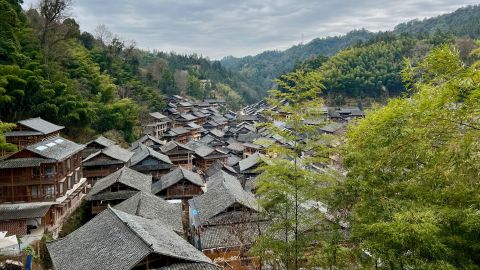
The bases of the mountains are chiseled with stepped rice paddies. Vegetables blanket the land nearby. Chicken and ducks roam on nearly every street. Pigs lay inside wooden pens.
Dali is surrounded by mountainous terrain, full of craggy, steep, and winding roads. The only way to get there is to walk or drive up a big mountain, then down into the valley. Dali’s remoteness means people here, over the centuries, have learned to be self-sufficient. They grow or raise most of their own food. Some families have vegetable patches next to their homes or plots of land closer to the mountains.
It’s pastoral and idyllic in many ways, but Dali Village can’t escape the economic realities of modernity.
A young woman, Xiao Qing, invited us into her home. Her parents and grandfather were wearing winter jackets, sitting around a small coal fire on the ground to stay warm. The concrete room was decorated sparsely, with a bunch of sweet potatoes hanging from the ceiling.
Xiao Qing’s father is only in his mid-40s, but his face is tan and weathered with wrinkles from years of hard labor. Her dad worked in factories while she was growing up. After Xiao Qing graduated from high school, she took the baton, went to the factories, and became the family breadwinner.
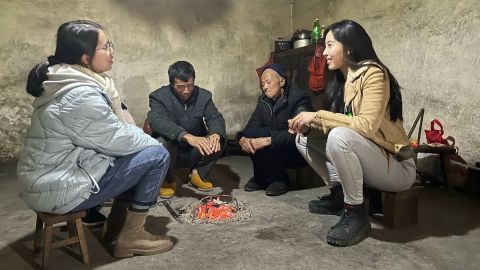
“I’ve been very homesick working away from home,” Xiao Qing said. “Staying at home means farming. Young people like us don’t get much income from farming.”
Only once a year, during the Lunar New Year, does she return from work in a cosmetics factory, 500 miles away in Guangdong province. Her story is echoed across all the families in Dali Village, and across rural China. Large swaths of China’s countryside are full of the elderly and young kids, with most of the working-age adults gone. They’re working in far-away factories as low-cost labor powering China’s status as the world’s largest manufacturer, while sending their earnings back home.
One villager puts it this way: leaving home to go far away is just a fact of life, there’s no other choice for survival.
We visited a young couple on the other side of the village, who live in a wooden home on the side of the mountain. They both work in factories in Guangdong province, making circuit boards.
His two young children, a boy and girl, were jumping on the couch behind us during the interview. His daughter, wearing a red Hello Kitty sweater, kept swinging her arms around her dad’s shoulders to give him a warm embrace.
He said his son could barely walk when he last saw him, but now, he’s running around. He didn’t return for the holidays until a few days ago, after midnight. “But my daughter, she insisted on waiting for me out here. When I walked through the door, I hugged her, but she had already fallen asleep.”
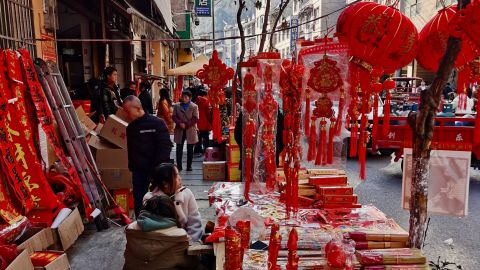
I didn’t see anyone wearing a mask in Dali Village, except for the few tourists coming through, nor did I see any Covid antigen tests, or much medicine lying around people’s homes. The sense of normalcy was surprising.
In Beijing, where I had just flown in from, many people were still wearing masks outside. When I visited hospitals in the city weeks before, they were overflowing with elderly patients. Common cold and fever medicine had sold out. Crematoriums were swamped. Families told me they had to wait days to cremate their loved ones.
When we first arrived in Guizhou, we landed in Tongren, a city about a four-hour drive from Dali. Our taxi driver said his family in the countryside had all been infected with Covid. He said many people he knew died at home, because they couldn’t afford to go to the hospital.
I tried to find out if Dali Village’s remoteness has shielded it in any way from China’s wave of Covid cases and deaths.
There was one funeral ceremony during our stay in Dali, but all the villagers said the deceased was a man in his 90s who died of old age.
Everyone I interviewed on camera said no one around them had been infected. A few elderly villagers I spoke to said they were fully vaccinated and hadn’t gotten sick. But I ran into a group of young people, eating hot pot outside, who said otherwise. I squatted next to them around the table, since there were no stools left. One of them, it turned out, is a doctor at a hospital in a nearby city.
“Almost all villagers have been infected. They had symptoms,” he told me, as he picked a piece of meat out of the boiling pot of soup with his chopsticks.
I asked him if the villagers knew whether it was Covid, or if they just thought it was a cold.
“It’s like a cold anyway,” another man interjected.
The doctor replied, with his back turned to the camera the whole time, “They just haven’t been diagnosed, but the symptoms match Covid. They just never tested.”
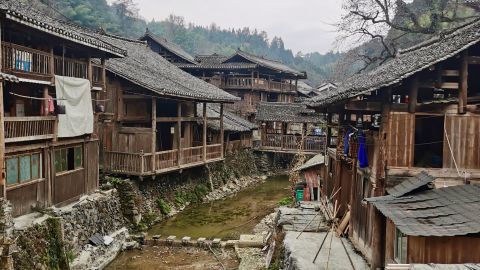
A group of six government officials greeted us the moment we arrived in Dali Village. It’s common for local officials to keep a close eye on foreign journalists in their jurisdiction, but they were especially persistent in this village, following our every move.
At least four of them booked rooms in our same hotel, or nearby. No matter how early we woke they would be waiting in the lobby, see us walking down the stairs and follow us.
We could often see them whispering to villagers soon before or after we interviewed them. They brought in another local official who spoke the Dong language, preventing any of us from understanding her conversations with villagers. All of the officials refused to clearly answer what their objective was, or what they were telling the villagers.
It quickly became apparent I would be unable to further investigate the Covid situation in the area, with the officials hovering over us. Hence, we drove out of the village to a public hospital in the neighboring county about two hours away, hoping the minders wouldn’t follow and that people would be more comfortable speaking freely.
The hospital’s fever clinic was almost entirely empty. The main hospital area had more people, but it wasn’t packed. It was a stark contrast to the images of overcrowded hospitals in major cities across China.
I wanted to know: had the peak of Covid infections already passed in this area?
We went to another floor of the hospital and asked a nurse if the place had been packed a few weeks ago. “It’s always packed and busy here,” she replied. She couldn’t say anything more because a doctor came through and interrupted, ending our interview.
One woman, a patient’s family member, told me outside the hospital that everyone around her already had been infected with Covid and then recovered.
Soon after, we realized we were being followed. A man approached us outside the hospital and said he was part of the propaganda department.
We showed him our press cards and told him we were here to report on the Covid situation and Lunar New Year festivities. We got in the car and left.
At a village clinic a 30 minute drive away, the same man and another woman followed us in.
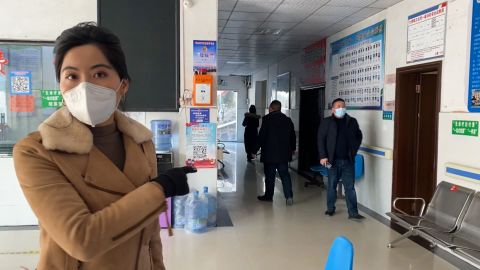
We saw them say something to the staff there, then suddenly no one would speak to us, so I went outside and asked nearby stores if they had seen lines outside the clinic a few weeks ago. Every time, the government minder would interrupt the conversation to speak to the interviewee, clearly telling them not to say anything.
The government officials again appeared at the next hospital we visited. This time, there were more of them. I tried confronting them, asking why they were following us. Anytime I spoke to them, they would immediately walk away and ignore me. Then, the moment I turned away, they would continue tailing us, while obstructing our reporting.
We drove to a nearby marketplace to grab lunch. The roads were lined with tents selling a kaleidoscopic array of Lunar New Year goods. Multiple stores were selling boxes of firecrackers stacked from floor to ceiling, with giant red banners and lanterns for sale hung on the outside of the tents. Live chickens, frogs, and fish were on sale, along with fresh produce. If you purchased a chicken, they would snap its neck on the spot.
At the corner of a street, a group of siblings were waiting in line for skewered, roasted meat and vegetables. We approached them, identified ourselves as journalists working for a foreign media network called CNN, and asked if anyone would speak to us about their Lunar New Year experience.
The young woman agreed. I had only asked her a few questions about how excited she was to be back and if it was hard to book a train ticket home, when a government minder suddenly walked into the middle of the interview, while we were still filming, and grabbed her away, abruptly ending our interview. He pushed her and her family away, then left them alone.
We left and headed to several more hospitals. But with the minders following and interfering, we couldn’t get responses from anyone.
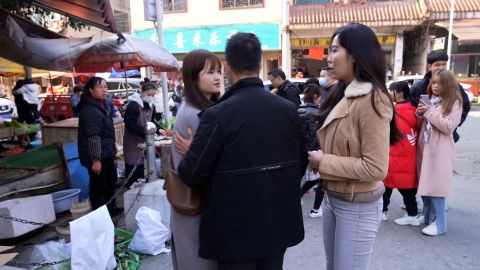
China’s CDC says the Covid peak across the country has passed since the government abandoned its zero-Covid policy.
It says that 80% of the population, or more than 1.1 billion people, have already been infected. Health authorities claim that visits to clinics for fever and Covid hospitalizations have declined since their peaks in late December and early January.
Experts say China’s population had almost no underlying natural immunity before reopening, while existing Chinese vaccines offer limited protection against infection from Omicron, so one massive wave ended up sweeping over the whole country – hitting rural and urban areas almost simultaneously.
What makes China different is that Covid “can spread like wildfire without any impediment”, said Yanzhong Huang, a senior fellow for global health at the Council on Foreign Relations. “The speed and scale of the spread challenged conventional wisdom. Almost at the same time Covid was wreaking havoc in urban areas, we saw the rapid increase of infections in many parts of rural China.”
But Huang adds that the government has not released accurate data on the scale and toll of the outbreak. The Chinese government says more than 72,500 people with Covid died in hospitals between December 8 and January 19, but the World Health Organization has suggested these numbers “under-represent the true impact of the disease.”
In rural areas, experts say there’s likely far more silent suffering. More people likely died at home because they couldn’t afford, or were unable, to get to the hospital.
Back in the village, we were greeted by the sounds of squealing pigs, getting ready to be slaughtered. This is an important part of the Lunar New Year tradition in Dali. Decades ago, for most countryside families, this was the only time of the year when they could afford to eat meat.
Now, it’s about bringing the family together to feast. Some of the families raise the pigs themselves, others buy them from sellers. I came across a truck of squealing pigs right at the village entrance. With a string tied around the pig’s hoof, a man tugged the pig out of the truck, using his whole body weight to drag it through the streets. All the while, the pig was screaming and using all of its might to stay put. The man used a stick to hit the pig, coaxing it to move.
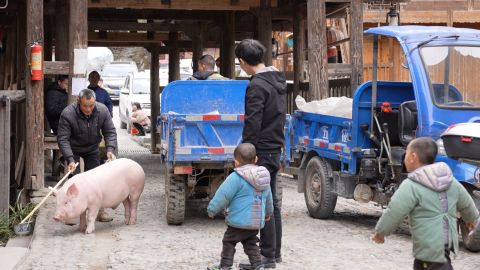
A woman next to the truck was watching, unfazed. She told me she was the one who sold him the pig. Now that people are allowed to gather and barbeque together, her business is booming.
Families pick a day shortly before the Lunar New Year holiday to slaughter the pig, either themselves or by hiring a butcher. They immediately smoke part of the meat to make “la rou” or cured pork belly, which can last them all year, but a portion of the meat is for feasting as soon as it’s cooked.
A villager we befriended over several days invited us to her home for their post-slaughtering feast. The extra pig carcass was laying in the middle of her home, divided into numerous giant metal bowls. Her house was packed with relatives, seated around two tables.
San Jie is popular in the village. She’s in her 50s, spunky, extroverted, and always smiling. Throughout the week, we saw relatives and friends constantly coming in and out of her home, either to borrow her tools and expertise, or simply to say hi. Groups of relatives frequently walk into her home with giant wooden buckets of piping hot sticky rice, harvested from the paddy fields nearby. They’d dump the rice into a machine in her home that turns it into a paste to make ciba, a traditional sticky rice cake. Every time we ran into her, she would insist we come inside to eat and open up her best vats of homemade liquor.
When San Jie was younger, she worked in a factory sewing jeans. Now, she uses her skills to make clothes and fabrics for villagers. She showed me the clothes they wear for different occasions, how they intricately wrap their hair, and how they adorn heavy silver neck pieces and ornaments.
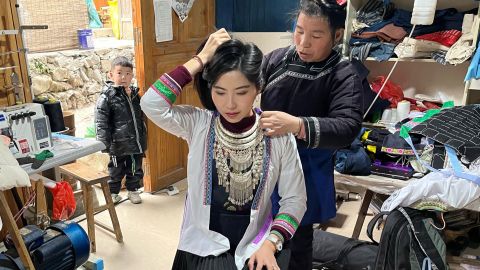
I touched a piece of intricately woven black and white cloth more than a meter long. She said making just a thin, inch-long strip of that cloth takes her more than a day of sewing.
I asked San Jie and the other elderly female family members if their children know how to make these clothes. Laughing, they said their children wouldn’t have the patience, but San Jie said she has taught her younger daughter how.
“I told my daughter it’s too tiring, too exhausting. My back and neck hurt. It’s all for your education,” San Jie said. “My daughter said, ‘Mom, let me help you’, so she learned.”
Her elder daughter works in a factory in Guangdong, leaving her two toddlers in her care. Her younger daughter, who is in high school, stood near the doorway during our whole conversation, engrossed in a mobile phone game. San Jie said she doesn’t need to waste time learning old traditions, but instead should focus on her studies.
We said our goodbyes in the village and got in the car for the long drive to the airport, our tummies full of sticky rice and our heads warm from rice liquor. We noticed the same car from before was following us all the way to the airport, and wondered how the minders in Dali would write up a report on our trip for their bosses in the propaganda department. They witnessed us befriend and learn from the hardworking Dali villagers, who are willing to do whatever it takes to give their children a better life.